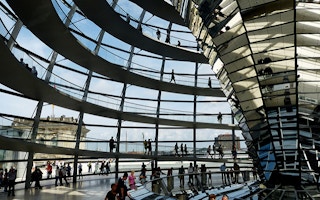The World Green Building Council (WGBC) has launched a groundbreaking project that will ensure all buildings are ‘net zero’ by 2050, in its bid to help deliver on the promise of the Paris Agreement to reduce global greenhouse gas emissions.
To continue reading, subscribe to Eco‑Business.
There's something for everyone. We offer a range of subscription plans.
- Access our stories and receive our Insights Weekly newsletter with the free EB Member plan.
- Unlock unlimited access to our content and archive with EB Circle.
- Publish your content with EB Premium.
Dubbed Advancing Net Zero, the project was announced by WGBC CEO Terri Wills at the Business and Climate Summit in London on Tuesday.
Under the project, WGBC will mobilise Green Building Councils in different countries to formulate plans to launch a national net zero certification programme.
The programme will then be rolled out to all buildings – both constructed and under construction – as soon as possible until all buildings are net zero by 2050.
In buildings, net zero certification is a highly sought-after mark as it means the building is capable of generating clean, renewable energy on-site to meet all of its heating, cooling, lighting and other electricity needs.
This makes the building independent of electricity grids, which burn fossil fuels for power generation.
Net zero also means the building produces net zero carbon emissions.
WGBC identified eight countries as the pilot sites for the project - Australia, Brazil, Canada, Germany, India, the Netherlands, South Africa, and Sweden. These countries’ building sectors are seen to have the biggest growth in the coming years.
The net zero certification will either be implemented as a stand-alone programme or as an addition to existing certification tools, such as Australia’s Green Star, which is a voluntary sustainability rating system for buildings launched by the country’s Green Building Council.
Specifically, the project targets all new buildings and major renovations to be net zero starting in 2030, meaning no buildings should be built below net zero standards.
The project also targets to certify 100 per cent of buildings as net zero by 2050.
“
This will be a long and challenging road but, together with the dedication and expertise of our Green Building Councils and partners, we can create a thriving market for highly-efficient buildings and make net zero the new normal.
Terri Wills, CEO, World Green Building Council
WGBC will tap on Architecture 2030, a US-based non-profit organisation founded by internationally-recognised architect Edward Mazria, as its lead partner.
Together with other green building associations identified with individual countries’ GBCs, Architecture 2030 will lend technical expertise in creating country-specific training for green building professionals and demonstrating how to design and construct green buildings.
The project aims to train 75,000 professionals worldwide on net zero building by 2030, and 300,000 by 2050.
It will also install a net zero certification tool in place for all GBCs which implement the certification scheme.
On the bold move to make highly efficient buildings commonplace in the next 35 years, Wills said “getting down to zero won’t be easy”.
“This will be a long and challenging road but together with the dedication and expertise of our Green Building Councils and partners, we can create a thriving market for highly efficient buildings and make net zero the new normal,” she said.
The building and construction industry has a pivotal role in reducing global CO2 emissions.
According to the Sustainable Buildings and Climate Initiative of the United Nations Environment Programme, buildings use about 40 per cent of global energy and emit approximately one-third of global GHG emissions.
This means that if the building sector operates at business-as-usual levels, it will contribute to 6 degree Celsius of global warming, WGBC said, citing estimates from the International Energy Agency (IEA).
Aiming for net zero buildings by 2050 is seen as an important move if the building sector were to reduce 84 gigatonnes of CO2 emissions, the equivalent of not building 22,000 coal-fired power plants, and keep global warming within 2 and even 1.5 degrees, WGBC said.










